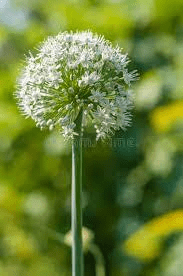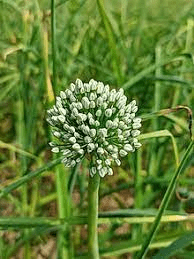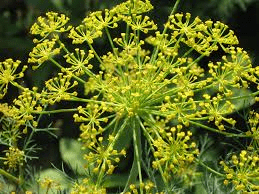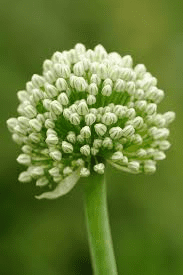Onion inflorescence refers to the flowering structure of the onion plant, scientifically known as Allium cepa. Onions, primarily grown for their edible bulbs, also produce a unique and distinctive flowering structure that plays a critical role in their reproduction.
The inflorescence of the onion plant is characterized by a globular cluster of small, star-shaped flowers, which collectively form a spherical or umbel-like head.
This structure is known as an umbel, a type of inflorescence where the flowers are borne on short stalks that radiate from a common point, resembling an umbrella. The onion’s inflorescence emerges from the center of the plant, rising above the foliage.
Each individual flower within the onion inflorescence is quite small, typically measuring just a few millimeters in diameter. The flowers are generally white or pale purple, and they have six tepals—three outer and three inner—that are often difficult to distinguish as separate petals and sepals.
The flowers also possess six stamens with anthers that release pollen and a single pistil with a stigma that receives pollen.
The flowering process begins with the development of a flower stalk, or scape, which elongates from the central bulb and supports the inflorescence.
As the flower head matures, the individual flowers open in a sequence, beginning from the outer edges and progressing inward. This sequential opening helps to ensure effective pollination, as it allows for a longer period of time during which pollinators, such as bees and other insects, can visit the flowers.
Pollination is a critical stage in the onion’s reproductive cycle. Onions are primarily cross-pollinated, meaning that pollen from one plant must be transferred to the stigma of another plant’s flower.
This process is facilitated by pollinators that are attracted to the onion’s flowers by their scent and nectar. Successful pollination results in the production of seeds, which will eventually be dispersed and germinate to produce new onion plants.
The fruit of the onion plant is a small, dry capsule that contains the seeds. Once the flowers are fertilized, the fruit develops and eventually splits open to release the seeds. These seeds are then dispersed by various means, including wind, water, or animals, and they can remain viable for several years.
The inflorescence of the onion plant is not only important for reproduction but also adds ornamental value to the garden. The spherical flower heads can be quite attractive and are often used in floral arrangements or as decorative elements in garden design.
Onion inflorescence is a fascinating aspect of the onion plant’s biology. Its distinct umbel structure, small flowers, and the process of pollination and seed production play crucial roles in the plant’s reproduction and contribute to its overall lifecycle. The beauty and functionality of the onion’s flowering structure highlight the plant’s adaptability and ecological importance.
The Economic Importance and Uses of Onion Inflorescence

1. Seed Production: Onion inflorescences are crucial for seed production. They produce onion seeds, which are essential for growing new onion crops. This process is vital for maintaining and expanding onion cultivation.
2. Culinary Uses: The flowering parts of onions, also known as onion blossoms, can be used as a culinary garnish or ingredient. They add unique flavors and textures to dishes and are sometimes used in specialty recipes.
3. Pollinator Attraction: Onion inflorescences attract pollinators such as bees and butterflies. This helps increase the biodiversity of the garden and supports the health of other plants by promoting pollination.
4. Traditional Medicine: In some cultures, onion inflorescences are used in traditional medicine. They are believed to have various health benefits, including anti-inflammatory and antioxidant properties.
5. Ornamental Use: Onion inflorescences can be used for ornamental purposes. Their spherical flower heads are attractive and are sometimes used in floral arrangements and garden displays.
6. Organic Pest Control: The strong scent of onion inflorescences can act as a natural deterrent for certain pests. They can be planted to repel insects and protect other crops.
7. Educational Purposes: Onion inflorescences are used in educational settings to teach about plant reproduction and the role of inflorescences in the life cycle of plants.
8. Compost Material: Onion inflorescences can be added to compost piles. They decompose and contribute organic matter, enriching the compost mix and benefiting soil health.
9. Soil Health Improvement: The decomposition of onion inflorescences adds valuable nutrients to the soil, improving its fertility and structure.
10. Research and Breeding: Onion inflorescences are important for research and breeding programs. They are studied to develop new onion varieties with improved traits and disease resistance.
11. Natural Dye: Onion inflorescences can be used to create natural dyes for textiles. They produce colors that can be used in crafting and art.
12. Bioactive Compounds: Onion inflorescences contain bioactive compounds that are studied for their potential health benefits. These compounds may have antimicrobial and anti-inflammatory effects.
13. Sustainable Farming: Utilizing onion inflorescences in crop rotation and integrated pest management helps promote sustainable farming practices.
14. Ecological Balance: Onion inflorescences contribute to ecological balance by supporting beneficial insects and promoting biodiversity in agricultural settings.
15. Aromatic Uses: The aroma of onion inflorescences can be used in making essential oils and natural fragrance products.
16. Medicinal Extracts: Extracts from onion inflorescences are used in some natural health products for their potential therapeutic properties.
17. Soil Amendment: Added to the soil, onion inflorescences help improve soil organic matter and enhance plant growth.
18. Conservation of Plant Species: Preserving onion inflorescences contributes to the conservation of onion varieties and the overall genetic diversity of the species.
Read Also: The Health Benefits of Using Jeera Spice on your Cooking
The Products and By-products That Can Be Derived From Onion Inflorescence

1. Onion Seeds: Produced for planting new onion crops and maintaining cultivation.
2. Culinary Garnishes: Used as a garnish or ingredient in specialty recipes.
3. Pollinator Habitat: Provides habitat and food for pollinators like bees and butterflies.
4. Traditional Medicine: Used in traditional remedies for their perceived health benefits.
5. Ornamental Arrangements: Used in floral arrangements and garden displays.
6. Organic Pest Repellent: Acts as a natural deterrent for garden pests.
7. Educational Material: Used in teaching about plant reproduction and inflorescences.
8. Compost Material: Added to compost piles to enrich the compost mix.
9. Soil Fertilizer: Decomposes to improve soil fertility and structure.
10. Research Material: Studied for breeding programs and development of new onion varieties.
11. Natural Dye: Used to create natural dyes for textiles and crafts.
12. Bioactive Extracts: Extracts used in health products for potential therapeutic benefits.
13. Sustainable Farming Inputs: Contributes to sustainable farming practices and crop rotation.
14. Ecological Contributions: Supports beneficial insects and promotes biodiversity.
15. Aromatic Products: Used in making essential oils and natural fragrances.
16. Medicinal Extracts: Incorporated into natural health products for therapeutic uses.
17. Soil Amendment: Added to soil to increase organic matter and improve plant growth.
18. Conservation Efforts: Helps in the conservation of onion species and genetic diversity.
Read Also: 5 Medicinal Health Benefits Of Campanula parryi (Parry’s Bellflower)
Frequently Asked Questions (FAQ’s) About Onion Inflorescence

1. What is onion inflorescence? Onion inflorescence refers to the flowering part of the onion plant that produces seeds and blooms in a spherical cluster.
2. How is onion inflorescence used in culinary applications? The flowers can be used as a garnish or ingredient, adding unique flavors and textures to dishes.
3. What are the benefits of onion inflorescence for pollinators? It attracts pollinators like bees and butterflies, which supports the health and productivity of the garden.
4. Can onion inflorescence be used in traditional medicine? Yes, it is used in some traditional remedies for its believed anti-inflammatory and antioxidant properties.
5. How does onion inflorescence contribute to soil health? When decomposed, it adds valuable nutrients to the soil, improving its fertility and structure.
6. Can onion inflorescence be used for pest control? Yes, its strong scent can help repel certain garden pests.
7. How is onion inflorescence utilized in research and breeding? It is studied to develop new onion varieties with improved traits and disease resistance.
8. Are there any ornamental uses for onion inflorescence? Yes, the spherical flower heads are used in floral arrangements and garden displays for their visual appeal.
9. What are the potential bioactive compounds in onion inflorescence? It contains compounds that may have antimicrobial and anti-inflammatory effects.
10. How can onion inflorescence be used in sustainable farming? It supports sustainable practices by contributing to crop rotation, integrated pest management, and promoting ecological balance.
Read Also: What Are The Benefits Of A Career In Agriculture?

